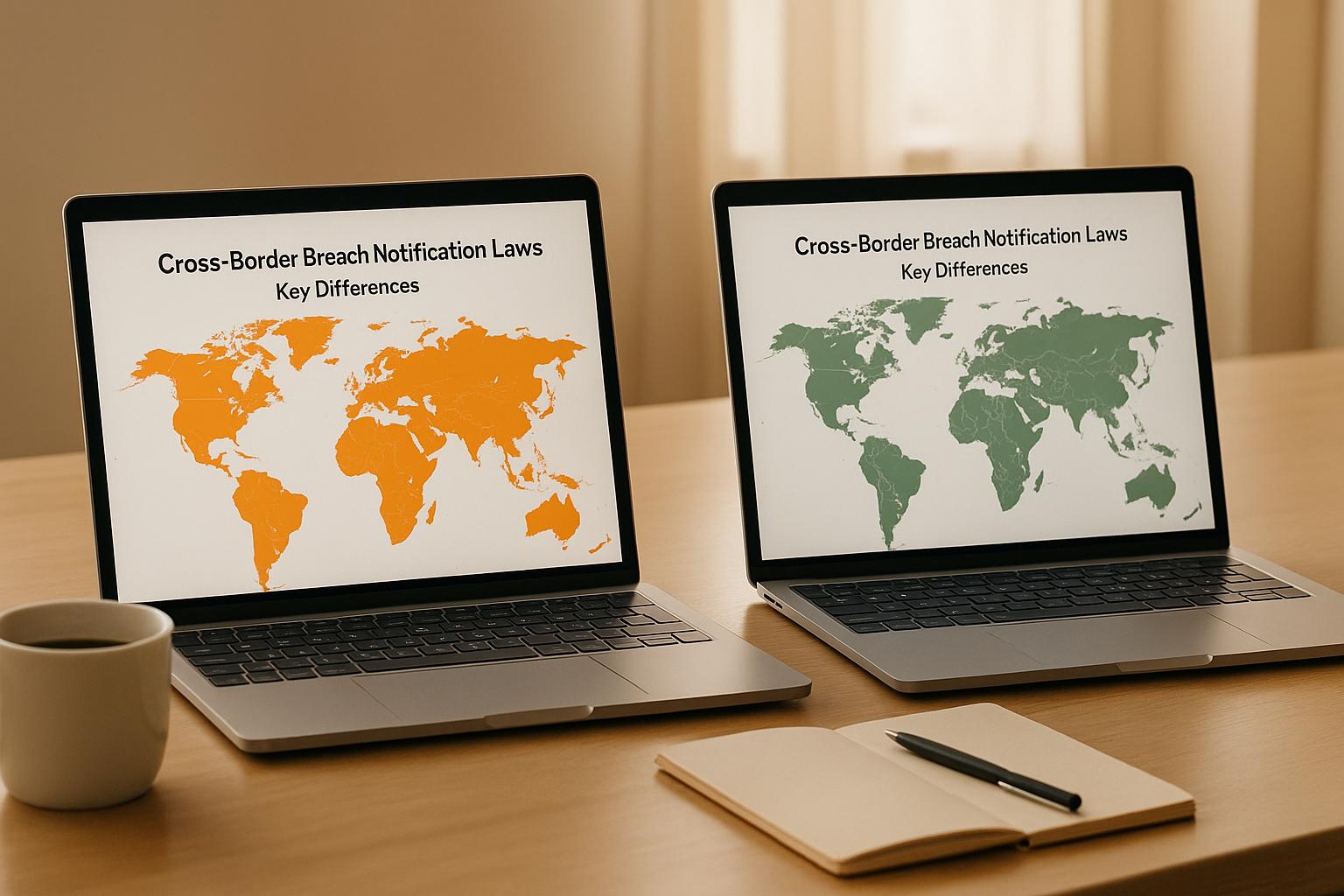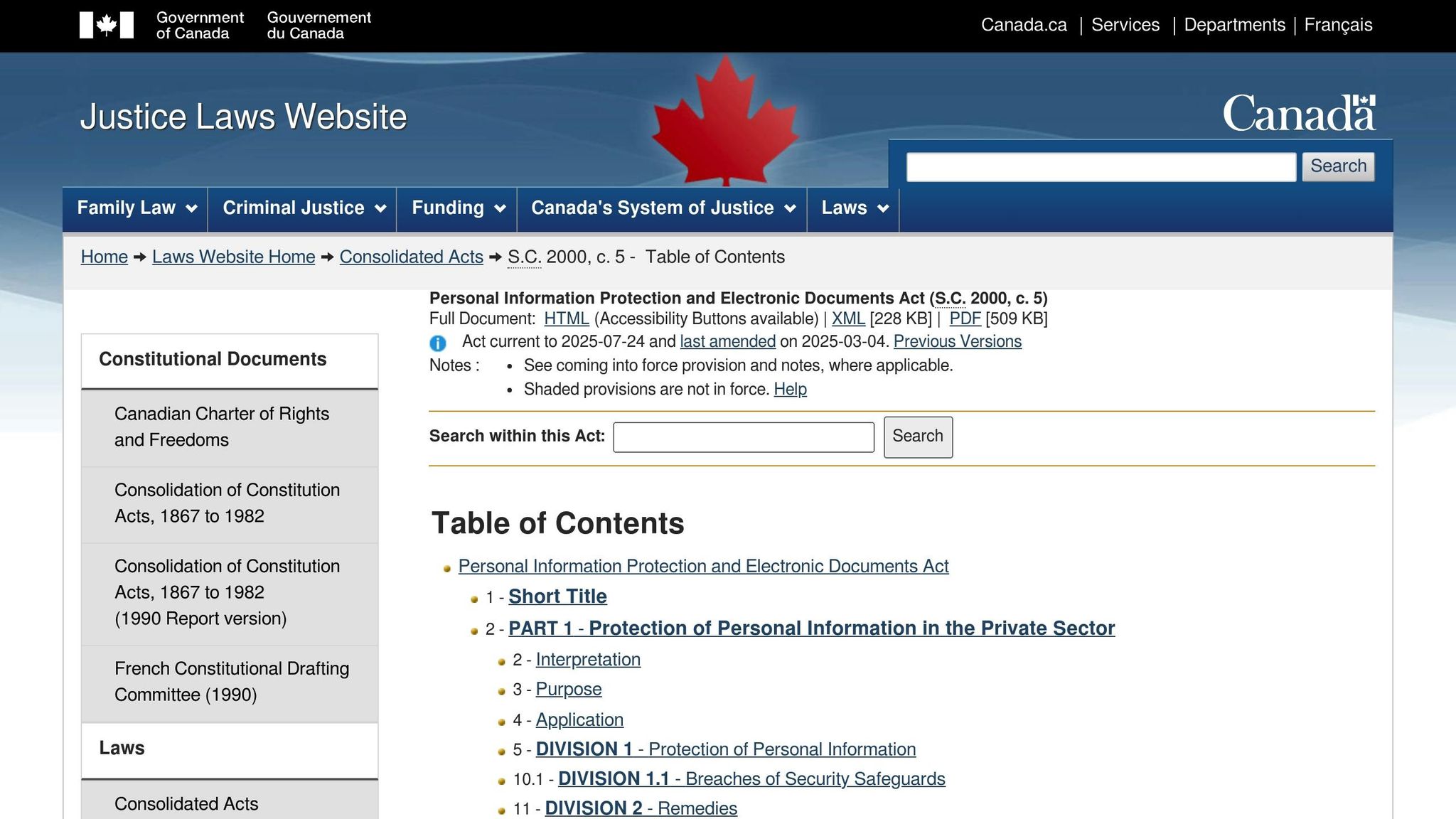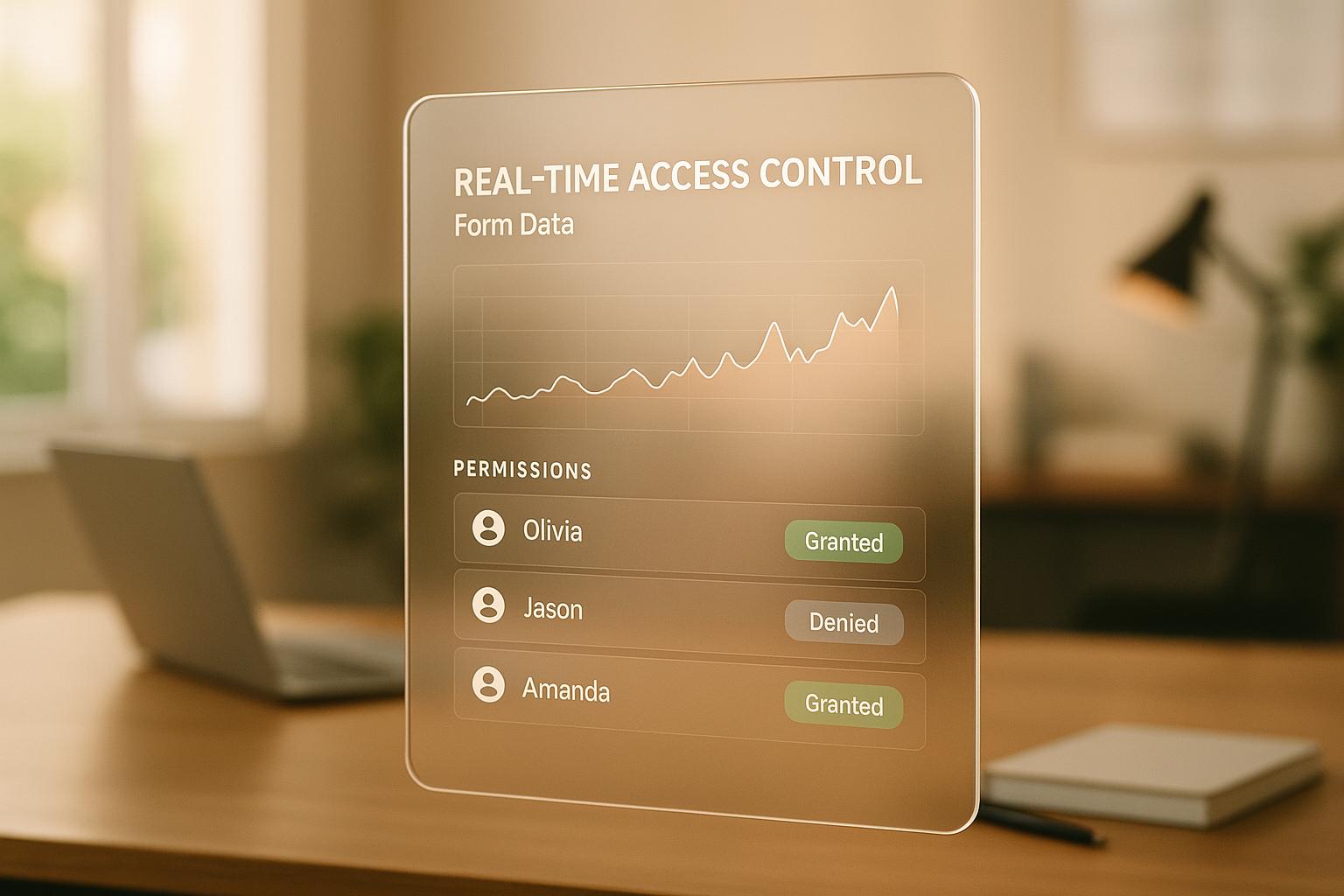Cross-Border Breach Notification Laws: Key Differences

Data breaches don’t stop at borders, and neither do the laws regulating them. If your business handles global data, you’re up against a maze of regulations. Here's the gist:
- EU (GDPR): Notify authorities within 72 hours of a breach if risks to personal rights exist. Fines can reach €20 million or 4% of global revenue.
- U.S.: State laws vary widely. Most prioritize notifying individuals over authorities, with deadlines ranging from immediate to 90 days.
- Canada: Federal and provincial rules differ. Breaches must be reported promptly if there’s a “real risk of significant harm.”
- Asia-Pacific: Countries like Australia and Singapore enforce breach notifications, but timelines and penalties vary significantly.
Each region’s approach reflects different priorities, timelines, and penalties. This fragmented landscape requires businesses to align their compliance strategies with the strictest applicable rules. The stakes? Massive fines, reputational damage, and operational disruptions. The solution? Clear incident response plans tailored to these varying laws.
How Do International Laws Affect Email Data Breach Notification? - TheEmailToolbox.com
1. European Union: GDPR
The General Data Protection Regulation (GDPR) enforces strict rules on breach notifications and imposes heavy penalties for non-compliance. Unlike the varied approaches seen in other parts of the world, GDPR establishes a consistent framework across all 27 EU member states.
Notification Timelines
Under GDPR, organizations must notify the relevant supervisory authority within 72 hours of becoming aware of a personal data breach, provided the breach poses a risk to individuals' rights and freedoms.
"In the case of a personal data breach, the controller shall without undue delay and, where feasible, not later than 72 hours after having become aware of it, notify the personal data breach to the supervisory authority competent in accordance with Article 55, unless the personal data breach is unlikely to result in a risk to the rights and freedoms of natural persons."
There are exceptions to this requirement. If the compromised data is encrypted and the encryption key remains secure, or if the breach poses minimal risk, notification may not be necessary. However, if the 72-hour deadline is missed, organizations must provide detailed justifications for the delay.
Authority and Individual Notification Requirements
GDPR employs a two-tier notification system. Beyond informing supervisory authorities within the mandated time frame, organizations must also notify affected individuals if the breach is likely to result in a high risk to their rights and freedoms.
"When the personal data breach is likely to result in a high risk to the rights and freedoms of natural persons, the controller shall communicate the personal data breach to the data subject without undue delay."
Penalties
GDPR's penalty system is divided into two levels based on the severity of the violation. For lesser infringements, such as certain failures in breach notification, fines can reach up to €10 million or 2% of the organization's global annual revenue, whichever is higher. More severe breaches can lead to fines as high as €20 million or 4% of worldwide annual turnover.
The UK follows a similar model. Organizations that fail to notify the Information Commissioner's Office (ICO) when required face fines of up to £8.7 million or 2% of global turnover.
Recent enforcement actions show regulators are not hesitant to impose substantial penalties. For example, Romania's data protection authority fined Agricola International SA €5,000 in July 2025 for inadequate technical measures that enabled a cyberattack. Similarly, Spain's regulator fined SIDECU, S.A. €96,000 in June 2025 for using facial recognition systems without proper legal justification or impact assessments.
Regulatory Trends
European regulators are increasingly assertive, adopting more sophisticated methods for calculating penalties. When determining fines, they examine factors such as the seriousness of the violation, whether it was intentional, mitigation efforts, cooperation with authorities, and the type of data involved.
"The fines must be effective, proportionate and dissuasive for each individual case."
A growing focus is on systemic non-compliance rather than isolated incidents. For instance, Italy's data protection authority fined Energia Verde S.p.A. €100,000 in April 2025 for multiple violations, including processing data without proper legal basis, insufficient security measures, and lack of cooperation with regulators.
The GDPR landscape continues to tighten, with stricter interpretations of its requirements. Breach notifications are no longer a simple procedural task - regulators demand robust incident response plans, clear communication strategies, and a demonstrated commitment to protecting personal data. This rigorous approach underscores the EU's firm stance on data protection, setting a benchmark for how other regions handle breach notification requirements.
2. United States: State-Level Laws
In contrast to the EU's streamlined GDPR framework, the United States operates under a web of state-specific data breach notification laws. Each state and U.S. territory has its own set of regulations, with no overarching federal law to provide uniformity. This fragmented structure not only complicates compliance for businesses within the U.S. but also creates hurdles for companies navigating international operations.
This patchwork system presents significant challenges for businesses working across multiple states. Data breaches have risen dramatically, from 421 incidents in 2011 to 1,579 in 2017, prompting states to revise their laws with differing requirements. The lack of standardization stands in stark contrast to the EU's cohesive approach, setting up an interesting comparison for analysis.
"While most state data breach notification statutes contain similar components, there are important differences, meaning a one-size-fits-all approach to notification will not suffice." - Foley & Lardner LLP
Notification Timelines
Most state laws are modeled after California's pioneering legislation, which laid the foundation for breach notification requirements. Generally, states require businesses to notify affected individuals promptly, though the exact timing varies widely. For instance, the District of Columbia mandates notification to both consumers and the Office of the Attorney General "without undue delay" [11]. Unlike GDPR's strict 72-hour deadline for notifying authorities, U.S. laws focus more on promptly informing individuals, with regulatory notification timelines remaining inconsistent across states.
Authority and Individual Notification Requirements
State laws typically require businesses to alert individuals when unencrypted sensitive personal data is accessed without authorization. Some states, like California, only require Attorney General notification for breaches above a specific size, while others, such as Maryland and the District of Columbia, enforce different or additional timelines. Notably, the District of Columbia allows businesses to notify the Attorney General first if delays in obtaining consumer contact information occur, rather than waiting to contact affected individuals [11].
Federal regulations add yet another layer of complexity. For example, under HIPAA, healthcare organizations and their business associates must notify both federal regulators and affected parties when a breach occurs.
Regulatory Trends
As cyber threats grow, states are broadening the scope of what constitutes personal information. Differences between state laws include thresholds for harm that trigger notification, requirements to notify law enforcement or credit agencies, expanded definitions of personal data, and varying penalties for non-compliance. Reporting obligations also differ, with many states requiring notification to the state Attorney General if breaches impact 500 or 1,000 individuals or more. These inconsistencies highlight the difficulties businesses face in navigating state-level compliance, a recurring theme as we explore data breach laws in other regions.
3. Canada: PIPEDA and Provincial Laws

Canada takes a unique approach to breach notification, blending federal oversight with provincial regulations. Unlike the uniformity of the GDPR or the patchwork of U.S. state laws, Canada’s framework operates on two levels. At the federal level, the Personal Information Protection and Electronic Documents Act (PIPEDA) sets the baseline. Meanwhile, provinces like Alberta, British Columbia, and Quebec have their own privacy laws, which often differ in requirements and enforcement. For businesses working across provinces, this multi-jurisdictional system can make compliance a challenging puzzle.
Navigating this system means understanding the varying thresholds for reporting breaches, timelines, and the authorities involved, all of which depend on where a business operates and the nature of its activities.
Authority and Individual Notification Requirements
Under PIPEDA, organizations must report breaches to the Privacy Commissioner of Canada and notify affected individuals if the breach presents a "real risk of significant harm" (RROSH). However, provincial laws introduce additional layers of complexity. Each province has its own rules, as summarized in the table below:
| Province/Federal | Authority Notification | Individual Notification | Harm Threshold |
|---|---|---|---|
| PIPEDA (Federal) | Privacy Commissioner of Canada | Required if RROSH | Real risk of significant harm |
| Alberta PIPA | Alberta OIPC | As ordered by OIPC | Real risk of significant harm |
| Quebec Act | Quebec CAI | Required | Risk of serious injury |
| BC PIPA | Not required | Best practice only | N/A |
For example, Alberta’s Personal Information Protection Act (PIPA) requires organizations to notify the Alberta Office of the Information and Privacy Commissioner (OIPC) when there is a real risk of significant harm, but individual notification is only mandated if ordered by the OIPC. On the other hand, Quebec’s privacy law is stricter, requiring organizations to notify both the Quebec Commission d'accès à l'information (CAI) and affected individuals if there’s a "risk of serious injury". Meanwhile, British Columbia’s PIPA does not mandate breach notifications but encourages it as a best practice.
Notification Timelines
Unlike GDPR’s strict 72-hour notification rule, Canada’s breach notification timelines are more flexible. Under PIPEDA, organizations are expected to notify authorities and individuals "promptly" after discovering a breach, though no specific timeframe is provided. This flexibility allows for thorough breach assessments but can leave organizations uncertain about compliance expectations.
Provincial laws offer slightly different guidance. For instance:
- Alberta’s PIPA requires reporting breaches to the OIPC "without unreasonable delay".
- Provincial health privacy laws often use terms like "at the first reasonable opportunity" to guide notification timelines.
- In Alberta and Yukon, health laws specify notification "as soon as practicable" or "as soon as reasonably possible", respectively.
This variability underscores the need for businesses to stay informed about the specific rules in each jurisdiction where they operate.
Penalties
Failing to comply with PIPEDA can result in fines of up to CAD $100,000 per violation. The Privacy Commissioner of Canada has the power to issue compliance orders, initiate legal proceedings, and publicly disclose violations. In severe cases, violations may be referred to the Attorney General of Canada, potentially leading to criminal charges.
Provincial enforcement is also becoming stricter. Starting January 1, 2024, Ontario’s Information and Privacy Commissioner can impose administrative monetary penalties of up to $50,000 for individuals and $500,000 for organizations under the Personal Health Information Protection Act. Criminal penalties can reach $200,000 for individuals and $1 million for organizations, with the possibility of imprisonment for up to a year.
Regulatory Trends
Canadian privacy regulators are increasingly shifting from reactive measures to proactive compliance. With 92% of Canadians expressing serious concerns about how their data is handled, regulators are urging businesses to prioritize prevention. This includes implementing robust security measures, conducting regular Privacy Impact Assessments, and investing in advanced data protection technologies.
Canada’s approach highlights how federal and provincial systems can coexist to provide strong privacy protections. However, the lack of standardized timelines and varying notification rules across provinces can make compliance a daunting task for businesses operating nationwide.
sbb-itb-5f36581
4. Asia-Pacific: Regional Frameworks
The Asia-Pacific region presents a diverse landscape when it comes to breach notification laws. Unlike the unified approach seen in the EU or North America, regulations here vary widely, reflecting the region's unique priorities. Countries like Australia, Singapore, and Japan have established detailed breach notification systems. On the other hand, places like Hong Kong and Malaysia currently lack such requirements. Meanwhile, nations like Indonesia and Thailand are developing their frameworks as their digital economies continue to grow.
Authority and Individual Notification Requirements
Notification requirements differ significantly across the region. Here's a breakdown:
- Australia: Organizations must notify the Office of the Australian Information Commissioner (OAIC) and affected individuals if a breach could result in serious harm.
- Singapore: Breaches meeting specific criteria must be reported to the Personal Data Protection Commission (PDPC) and impacted individuals.
- Japan: Notification to the Personal Information Protection Commission (PIPC) and data subjects is required for breaches involving sensitive data, property damage, unlawful use, or affecting over 1,000 individuals.
- South Korea: Breaches involving at least 1,000 individuals require notification.
- Philippines: Incidents involving sensitive personal data that pose risks like identity fraud or significant harm must be reported.
- Thailand: Data controllers must notify the PDPC, with individuals being informed only in high-risk cases.
- China: Authorities must be informed of breaches involving personal information, but individual notification is only required if ordered by regulators.
- India: Notifications to the Data Protection Board and affected individuals are required, though specific guidelines are still being developed.
Notification Timelines
Timelines for reporting breaches also vary widely:
- Singapore: Notification to the PDPC must happen within three days, with affected individuals informed immediately.
- Thailand and Philippines: Both follow a 72-hour deadline for breaches involving sensitive personal data.
- Japan: Immediate notification to the PIPC is required (within three to five days), with a detailed report due within 30 days - or 60 days for breaches involving unlawful purposes. Data subjects must also be informed promptly.
- Australia: Notifications must occur "as soon as practicable", with organizations allowed up to 30 days for assessment.
- South Korea: A five-day window is allowed for breaches affecting 1,000 or more individuals.
- Indonesia: Both authorities and affected individuals must be notified within three days.
These varying timelines reflect the region's regulatory diversity, which is also evident in the penalties imposed.
Penalties
Penalties for non-compliance vary greatly across Asia-Pacific, showcasing the different approaches taken by each jurisdiction:
- Australia: Among the world's highest fines - AUD 50 million, three times the benefit gained, or 30% of adjusted turnover.
- Singapore: Fines can reach SGD 1 million or 10% of annual local turnover.
- India: Penalties can go up to INR 250 crores (around $25 million) per violation.
- Indonesia: Administrative fines can reach 2% of annual revenue, alongside criminal sanctions, including six years imprisonment and fines up to IDR 6 billion (approximately $400,000).
- Japan: Fines for mishandling personal information can go up to JPY 100 million (around $689,000).
- Philippines: Penalties range from 0.5% to 3% of annual gross income, plus PHP 5 million (about $95,000) and possible six-year imprisonment.
- Hong Kong: Maximum fines of HKD 50,000, up to two years imprisonment, and daily penalties of HKD 1,000.
Regulatory Trends
The Asia-Pacific region is seeing a clear shift toward stricter enforcement. While many countries are inspired by frameworks like GDPR, they adapt these models to suit local needs. For instance, jurisdictions like China, Vietnam, and India don't recognize "legitimate interests" as a basis for processing data, unlike GDPR. China's Personal Information Protection Law focuses heavily on data sovereignty and localization, whereas India's Digital Personal Data Protection Act takes a different approach, avoiding such restrictions. This evolving regulatory environment creates both challenges and opportunities for businesses navigating multiple markets in the region.
Pros and Cons
Here's a quick overview of the key advantages and challenges tied to breach notification requirements in different regions:
| Region | Pros | Cons |
|---|---|---|
| European Union (GDPR) | Enforces a strict notification deadline of 72 hours. | No specific drawbacks identified in the source. |
| United States | State laws provide flexibility with deadlines ranging from 30 to 90 days. | Fragmented state regulations make coordination more complex. |
| Asia-Pacific | Example: Australia requires notification within 30 days. | Diverse regional rules can make compliance more challenging. |
The EU's 72-hour rule pushes for swift action, ensuring quick disclosure. On the other hand, the U.S. allows more time for investigation but requires companies to navigate a maze of state-specific laws. Meanwhile, the Asia-Pacific region presents a mix of requirements, underscoring the need for tailored approaches to compliance across different countries. These differences are crucial for global organizations to factor into their compliance strategies.
Conclusion
Understanding and adhering to cross-border breach notification laws is no small feat, especially with the varying regional requirements. The differences in breach notification deadlines alone highlight the complexities of compliance, particularly in regions like Asia-Pacific, where local legislation significantly influences notification protocols. These variations reflect fundamentally different approaches to data protection, and mishandling them can lead to hefty financial consequences.
For instance, GDPR violations can result in fines as steep as 4% of a company’s annual global turnover. Meanwhile, under the CCPA, penalties can reach up to $7,500 per violation. A stark example of these repercussions occurred in 2024 when a ransomware attack on a French hospital compromised 500,000 patient records. The hospital faced a €3.2 million fine for missing the 72-hour notification window. Under the updated 2025 GDPR rules, such breaches would face even harsher penalties, with fines potentially doubling.
Given these risks, having a well-integrated incident response plan is not just advisable - it’s essential. For global organizations, this means creating unified response strategies that align with the strictest regulatory requirements across jurisdictions. Key steps include implementing advanced monitoring systems, performing regular audits tailored to specific regions, training staff on local compliance rules, and leveraging tools like automated deadline tracking and centralized authority identification.
When handling sensitive data, businesses need reliable tools to ensure compliance from the outset. Platforms like Reform provide indispensable features such as spam prevention, email validation, and real-time analytics, all of which help maintain data quality and security - critical components in preventing breaches. Additionally, its seamless integration with CRM and marketing tools supports effective data governance.
As enforcement becomes tougher across jurisdictions, proactive compliance is no longer optional - it’s a necessity for staying competitive. Companies that invest in comprehensive cross-border compliance strategies now will be better prepared to navigate an increasingly complex regulatory environment, avoiding the severe costs of non-compliance and ensuring long-term resilience.
FAQs
How can businesses comply with cross-border breach notification laws effectively?
To handle cross-border breach notification laws effectively, businesses need a centralized compliance framework that adheres to the strictest regulations across different regions. For instance, the timelines for reporting vary significantly - GDPR requires notification within 72 hours, while HIPAA allows up to 60 days. Understanding these differences and setting up systems to meet the shortest deadlines is key.
Automating breach detection and reporting processes can make compliance more efficient, while clear internal protocols help maintain consistency across the organization. Additionally, regular staff training plays a critical role in ensuring employees are equipped to handle varying legal requirements and reduce compliance risks. With a proactive and well-structured approach, businesses can better manage the challenges of navigating cross-border regulations.
How do breach notification timelines differ between the EU, U.S., and Asia-Pacific regions?
Breach notification timelines can differ greatly depending on the region. In the EU, the GDPR mandates that organizations inform authorities within 72 hours of identifying a breach, particularly if it presents a significant risk to individuals. In the U.S., the timeline is dictated by state laws, typically falling between 30 and 90 days, though some states require notification within 72 hours or even immediately. Meanwhile, in the Asia-Pacific region, the rules vary by country - some demand notification within 48 hours, while others permit 72 hours or longer, depending on local regulations.
For businesses operating across borders, grasping these regional differences is essential to staying compliant and avoiding legal consequences.
How can a company create an effective incident response plan that complies with international data protection laws?
To create a solid incident response plan that meets international data protection laws, start by pinpointing the specific legal requirements in every region where your business operates. For instance, the General Data Protection Regulation (GDPR) mandates breach notifications within 72 hours, while HIPAA allows a 60-day window for notifying affected parties.
Your plan should outline clear steps for identifying, containing, and reporting data breaches. Assign distinct roles and responsibilities to your team to ensure accountability during incidents. It's also crucial to revisit and revise the plan regularly - at least once a year - to keep up with changing regulations. Incorporating global frameworks like ISO 27001 can provide a strong structure for managing incidents and maintaining uniformity across different regions.
Related posts
Get new content delivered straight to your inbox

The Response
Updates on the Reform platform, insights on optimizing conversion rates, and tips to craft forms that convert.
Drive real results with form optimizations
Tested across hundreds of experiments, our strategies deliver a 215% lift in qualified leads for B2B and SaaS companies.





